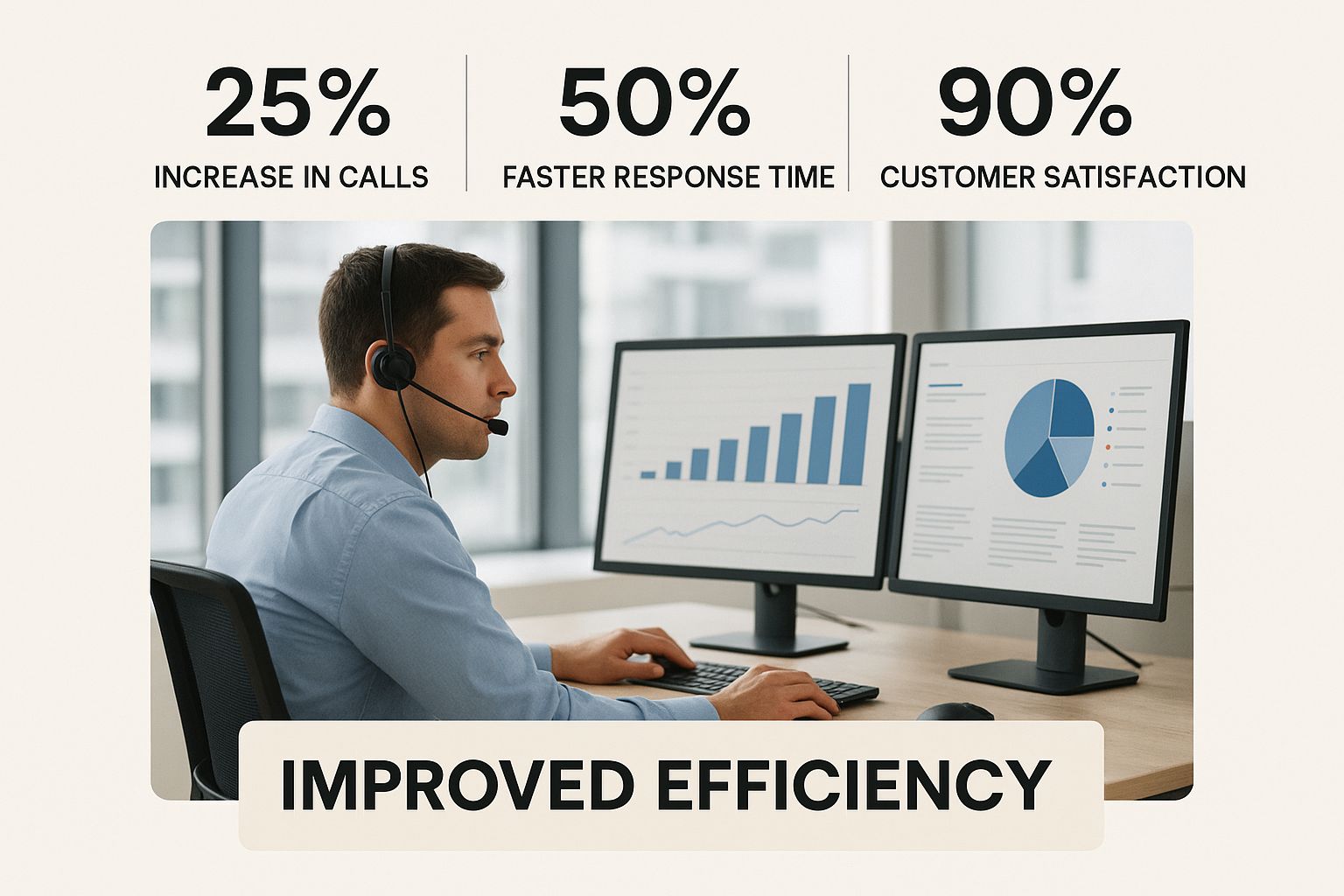Smarter Service with Call Center Automation Solutions
Think of call center automation as the tech that handles customer interactions and internal tasks without needing a human to step in for every single thing. It’s a move away from having agents manually handle every call and ticket to using smart, self-sufficient systems.
These tools are built to answer common questions, get calls to the right place, and gather basic information. This frees up your human agents to focus on the tougher, more nuanced problems that really require their expertise.
Moving Beyond Manual Customer Service
Imagine a library where, for every single book request, a librarian had to walk up and down endless aisles, manually searching the shelves. That’s what old-school call centers felt like.
Now, picture a powerful digital search engine that finds exactly what you need in a fraction of a second. That's the kind of leap we're talking about with call center automation. It represents a fundamental shift from relying solely on manual agent work to bringing in intelligent, automated systems.
This change isn't just happening for the sake of new technology. It's a direct response to some very real business challenges. Call volumes are exploding, and customers now expect instant, 24/7 support. The old way of doing things just can't keep up. Automation has gone from a "nice-to-have" to a strategic necessity for any business that wants to survive and grow.
Why Automation is Now Essential
The reasons businesses are jumping on board are pretty clear. Automation directly tackles the inherent weak spots of a purely human-powered support model—things like high operational costs, agent burnout from mind-numbing repetitive tasks, and wildly inconsistent service quality.
Here’s how it helps:
- Handling High Volume: An automated system can juggle thousands of simple inquiries at the same time without breaking a sweat.
- Ensuring Consistency: Bots and IVRs deliver the same, correct answer every single time, which completely removes the risk of human error on those routine questions.
- Improving Agent Focus: By taking the simple, repetitive work off their plates, automation lets your human agents save their brainpower for high-stakes, emotionally complex customer issues where they can really make a difference.
This strategic shift is playing out in the market numbers. The global call center automation market is expected to balloon from USD 37.4 billion in 2025 to a massive USD 76.8 billion by 2035.
This incredible growth is being driven by technologies like Intelligent Call Routing and modern Interactive Voice Response (IVR) systems that massively boost efficiency. If you want to dive deeper into the AI making this possible, check out our guide on what is conversational AI. The trend is undeniable: automation is the cornerstone of building a modern, resilient, and truly customer-focused support operation.
The Technology Powering Your Automated Call Center
To really get what call center automation is all about, you need to peek under the hood at the technologies making it all happen. It’s not just one magic bullet; it's more like a well-oiled machine with several key parts working in perfect harmony to handle customer requests smoothly.
The two workhorses you've probably encountered are Interactive Voice Response (IVR) and Automatic Call Distribution (ACD). Think of the IVR as the friendly digital receptionist that first greets you, offering a menu of options to figure out why you’re calling. The ACD is the smart traffic cop that takes that information and zips your call to the right person or department—whether that’s a billing specialist, a technical expert, or the next available agent.
The Game-Changer: AI and Intelligent Bots
While IVR and ACD set the stage, artificial intelligence is what really brings the house down. AI-powered chatbots and voicebots have become the tireless front-line crew, ready to jump in 24/7. They can instantly tackle the simple, repetitive stuff—like checking an order status or resetting a password—which frees up human agents for the tricky problems that need a real person's touch.
This infographic gives a great visual of how these different pieces fit together to drive real results.

As you can see, when you combine smart automation with well-equipped agents, you get a serious boost in efficiency. It's about working smarter, not just harder.
To give you a clearer picture, here’s a quick breakdown of the core technologies and what they actually do.
Key Automation Technologies and Their Functions
| Technology | Core Function | Primary Benefit |
|---|---|---|
| Interactive Voice Response (IVR) | Greets callers and routes them using voice commands or keypad inputs. | Filters and directs inquiries, reducing the need for a live receptionist. |
| Automatic Call Distribution (ACD) | Intelligently routes calls to the best-suited agent based on skills, availability, etc. | Minimizes wait times and ensures customers reach the right expert quickly. |
| AI Chatbots & Voicebots | Handle routine customer queries through text or voice conversations. | Provides instant, 24/7 support and resolves simple issues without human help. |
| Robotic Process Automation (RPA) | Automates repetitive back-office tasks like data entry and report generation. | Frees up agents from administrative work so they can focus on customers. |
Each of these tools plays a specific role, but their real power is unlocked when they work together, creating a seamless flow from the moment a customer reaches out.
Putting It All Together for Maximum Impact
It's not all about what the customer sees and hears, either. A huge part of automation happens behind the scenes with Robotic Process Automation (RPA). This is the technology that takes care of the tedious, manual tasks that can bog down your team—things like updating CRM records after a call, sending a confirmation email, or pulling data for a report. If you want a deeper dive, our guide on what is robotic process automation is a great place to start.
Ultimately, the goal is to use tools like automated phone calls to handle the predictable work, letting your human experts focus on the complex, high-value conversations that build real customer loyalty.
The big idea here isn't to replace your human agents. It's to supercharge them. Automation handles the grunt work, so your people can focus on the things they do best: problem-solving, showing empathy, and building relationships.
This isn't just a trend; it's a fundamental shift. A Deloitte survey found that a whopping 79% of contact center leaders are planning to spend more on AI. And get this—some analysts predict that by 2027, AI and RPA could cut the time agents spend on calls and administrative follow-up by as much as 40%. It’s all about creating a smarter, more responsive support system that benefits everyone.
The Real-World Benefits of Automating Customer Support
Bringing call center automation solutions into your workflow isn't just about adding new tech—it's about seeing real, measurable results that ripple through your entire support team. The first place you'll feel the impact? Your budget. Automation takes a huge bite out of operational costs by letting smart bots and IVR systems handle the flood of routine questions that used to tie up your agents.
But it’s not just about saving money; it’s about a massive leap in efficiency. These automated systems work 24/7/365 without needing a coffee break. That means your customers get instant help with common questions, no matter what time it is. This around-the-clock availability is exactly what people expect these days.

Enhancing the Customer Journey
Beyond sheer efficiency, automation makes your customer's life easier. Think about it: when simple questions like "Where's my package?" or "What's my balance?" get answered in seconds, frustration disappears. No more hold music—just quick, satisfying answers.
This kind of immediate, smooth support is what turns an annoyed caller into a happy, loyal customer. Salesforce found that only 13% of customers feel companies make it easy to solve their problems, which is a massive gap you can fill. Automation helps close that gap by making simple interactions painless. It's a huge piece of the puzzle if you want to know how to improve customer experience in a meaningful way. For a great deep-dive, resources on customer support automation can offer more ideas for raising your service quality.
Empowering Your Human Agents
This might be the most underrated perk: automation is a game-changer for your human agents. When you take the repetitive, mind-numbing questions off their plate, you see a huge boost in morale and job satisfaction.
Instead of getting burned out on the same old queries, your agents can finally focus on what humans do best:
- Tackling Complex Problems: They get to dig into the tricky, nuanced issues that require a human touch and real empathy.
- Building Relationships: Agents have the time and energy for quality conversations that build genuine trust and loyalty.
- Adding Strategic Value: Their role shifts from just closing tickets to proactively solving problems that help the whole company improve.
By automating the simple, you empower your team to excel at the complex. This not only cuts down on agent turnover but also elevates the skill and strategic importance of your entire support department.
This approach transforms your call center from a necessary expense into a powerhouse for customer retention and growth. It's an investment that pays off in both efficiency stats and human potential, creating a smarter, stronger support system.
How Top Companies Are Winning With Automation Right Now
It's one thing to talk about theory, but it’s another to see call center automation solutions making a real difference in the wild. The best companies aren't just plugging in new tech; they're strategically using it to fix specific problems, make customers happier, and get a leg up on the competition. These examples show how automation goes from a buzzword to a tool that actually gets results.
You'll notice they aren't trying a one-size-fits-all strategy. Instead, smart businesses are finding their biggest pain points—the things that slow them down and frustrate customers—and applying automation like a scalpel. This targeted approach is how they get a great return on their investment and solve real-world problems for both their customers and their own teams.
Let's look at a few examples of how this plays out across different industries.
E-commerce Brands Mastering the "Where's My Order?" Question
If you've ever worked in online retail, you know the number one question is always, "Where is my order?" It's a constant flood of simple, repetitive inquiries, making it the perfect job for automation.
One major e-commerce brand did exactly this. They set up an AI-powered chatbot and connected it directly to their order management system. The impact was huge:
- The chatbot now handles over 70% of all order status questions on its own, with no need for a human agent to step in.
- Customers get instant answers anytime, day or night, right on the website or through their favorite messaging app.
- This has freed up their support team to deal with the tricky stuff—things like damaged shipments, complex returns, or talking to a high-value customer who needs a bit more attention.
By automating just this one task, the company slashed the team's repetitive workload and made customers happier by giving them instant answers.
Healthcare Networks Making Patient Access Easier
In healthcare, getting information or an appointment quickly is everything. A regional healthcare network was struggling with long hold times for simple requests, which was understandably frustrating for patients. They turned to a smart Interactive Voice Response (IVR) system to take the pressure off.
Now, their automated system easily manages:
- Appointment Scheduling: Patients can book, change, or confirm their appointments just by using their voice.
- Prescription Refills: The IVR can verify a patient's identity and send standard refill requests straight to the pharmacy.
- Clinic Information: Callers can get clinic hours and directions without ever having to wait for a person to pick up.
This move dramatically cut down wait times for patients. Just as importantly, it allowed the administrative staff to stop answering the same basic questions all day and focus on more complex work like coordinating patient care or handling tricky insurance issues.
These examples really drive home a key idea: good automation isn’t about replacing people. It’s about elevating them. By letting the machines handle the predictable, you free up your people to handle the exceptional.
Financial Institutions Building Security and Trust
When it comes to money, security is everything. A leading bank is now using automation to send out instant fraud alerts, giving customers the power to act immediately. The moment their system flags a suspicious transaction, an automated workflow kicks in.
The system sends an automated text message and places a voice call to the customer, asking them to simply confirm or deny the charge. This isn't just about stopping fraud in its tracks; it's about building incredible trust. Customers feel safer knowing their bank is watching out for them 24/7, which goes a long way in building lasting loyalty.
Hearing What Your Customers Truly Mean
Some of the most powerful automation tools don't just route calls or answer basic questions—they actually listen. I’m not talking about just hearing words. I mean analyzing conversations to understand the genuine emotion and intent behind them. This is the world of speech and sentiment analysis, and frankly, it’s a total game-changer for understanding your customer base on a much deeper level.
Imagine your system could automatically flag a caller’s rising frustration from the sound of their voice, even if the words they use are perfectly polite. This technology goes way beyond simple transcription. It interprets the nuances—the pitch, pace, and volume of someone's voice—to get a real-time read on how they're feeling. It’s like giving your support system a dose of emotional intelligence.
Turning Conversations into Actionable Insights
This is where raw call data goes from being a simple record to a serious strategic asset. By analyzing sentiment across thousands of calls, you can start to spot hidden friction points in your customer journey that would otherwise fly completely under the radar.
You might discover, for example, that every time a specific product feature is mentioned, the customer's tone becomes frustrated. That’s a massive red flag signaling an urgent need for a UX update or maybe just clearer instructions.
This real-time analysis opens up some incredibly powerful possibilities:
- Proactive Churn Prevention: The system can pinpoint customers who are at risk of leaving by detecting signs of extreme dissatisfaction. This allows a manager to jump in and try to save the relationship before it's too late.
- Live Agent Coaching: If an agent is on a tough call and the customer's sentiment plummets, the system can feed them real-time prompts or suggestions to help de-escalate the situation.
- Compliance Monitoring: Automation can instantly flag calls where agents might have missed a required compliance statement or used language that doesn't meet company standards.
By analyzing not just what customers say, but how they say it, you get the complete picture of their experience. This lets you get ahead of problems instead of just reacting to them after the damage is done.
The growth here is huge. The speech analytics market is on track to blow past USD $6 billion by 2029, and it’s being driven by its ability to automate the review of conversations for sentiment, agent performance, and compliance. The healthcare sector, in particular, is adopting these AI-powered tools at a rapid pace. For more context, check out these call center statistics and growth figures from Giva Inc..
Ultimately, this technology helps you hear what your customers are really saying, which is the first step toward building a more responsive and empathetic business.
Building Your Call Center Automation Roadmap

Ready to get started? A successful automation strategy isn't about flipping a switch and hoping for the best. It's about building a practical, step-by-step plan that carefully weaves new technology into your business goals and, just as importantly, your team's daily work.
The best place to begin is with the low-hanging fruit. Take a hard look at the most common, mind-numbingly repetitive tasks your agents handle every single day. Are they stuck in a loop of answering "where is my order?" or resetting passwords? These high-volume, low-complexity queries are prime candidates for your first wave of automation.
By automating the simple, predictable stuff first, you score quick wins. These early successes prove the value of the investment, build momentum for the project, and let you learn as you go.
Once you’ve identified what to automate, the next big step is choosing the right technology partner. This decision is about more than just a slick feature list or a low price tag; it’s about finding a platform that can grow and adapt right alongside your business.
Choosing Your Technology and Preparing Your Team
When you’re looking at different call center automation solutions, you need to ask some tough questions about integration and scale. Can this platform talk to your existing CRM without a massive headache? If your call volume suddenly doubles, will it crash and burn or scale up seamlessly? A flexible partner is absolutely essential for long-term success.
But here’s the thing: technology is only half the battle. The most critical piece of your entire roadmap is your people. Bringing in automation means preparing your team for a new way of working. It's vital to frame this change not as a threat, but as a powerful new tool that will make their jobs better.
Think about taking these steps with your team:
- Communicate the "Why": Be crystal clear about how automation will take over the boring, routine work. This frees agents to tackle more interesting problems that actually require a human touch.
- Invest in New Skills: Roll out training programs designed to upskill your team. Focus on developing their critical thinking, complex problem-solving, and emotional intelligence—skills no bot can replicate.
- Create a Supportive Culture: Build an environment where technology is seen as an assistant, not a replacement. When people feel empowered by their tools, everyone wins—your employees and your customers.
A well-thought-out roadmap doesn't just manage the transition; it transforms your call center into a smarter, more efficient, and ultimately more human-focused operation.
Answering Your Questions About Call Center Automation
When you start looking into call center automation, a few big questions almost always pop up. Let's tackle them head-on, because clearing up these common concerns is the first step to seeing how powerful these tools can really be.
The biggest worry? "Will this replace my team?" Honestly, that's not the point at all. The goal is to make your human agents better, not obsolete. Think of automation as the team member who loves handling all the repetitive, high-volume tasks. This frees up your people to focus their brainpower on the tricky, emotional, or complex problems where a human touch truly makes a difference. Their role becomes more valuable, shifting from rote tasks to high-impact problem-solving.
Is This Only for Big Companies?
Another question I hear a lot is whether this kind of tech is out of reach for smaller businesses. A decade ago, that was definitely true. You needed a massive budget and a dedicated IT department to even think about it. But things have changed completely.
The game-changer has been cloud-based software and flexible pricing. You no longer need a huge upfront investment. Many providers offer scalable plans that let small and mid-sized businesses tap into the same powerful automation that the giants use, but at a fraction of the cost.
The new way of thinking about call center automation isn't about replacing people; it's about empowering them. When you automate the routine, you free up your team to be exceptional.
How Do I Know if It’s Working? Measuring ROI
Of course, the bottom-line question is always about the return on investment (ROI). How can you prove this is actually paying off? You track it by looking at a few key areas:
- Cost Savings: The most direct metric. How many agent hours are you saving on tasks that are now automated? This is a straightforward calculation.
- Efficiency Gains: Are you solving more problems on the first try? Look for a jump in your First Call Resolution (FCR) rate and a drop in your Average Handle Time (AHT).
- Happier Customers: Keep a close eye on your Customer Satisfaction (CSAT) and Net Promoter Score (NPS). When customers get faster answers to simple questions, these scores almost always improve.
- Agent Satisfaction: Don't forget your team. When agents are less bogged down by tedious work, their job satisfaction goes up. This often leads to better performance and lower employee turnover.
Ready to see how AI and automation can transform your operations? MakeAutomation specializes in building and implementing AI solutions that streamline workflows, boost efficiency, and drive growth. Book a consultation with us today!







